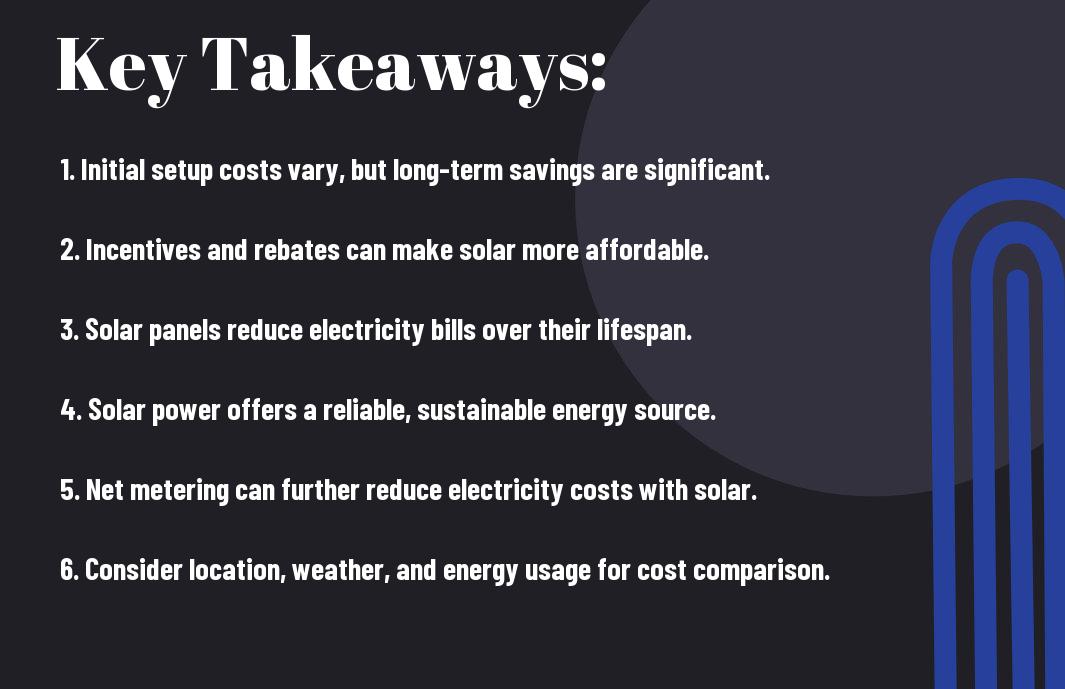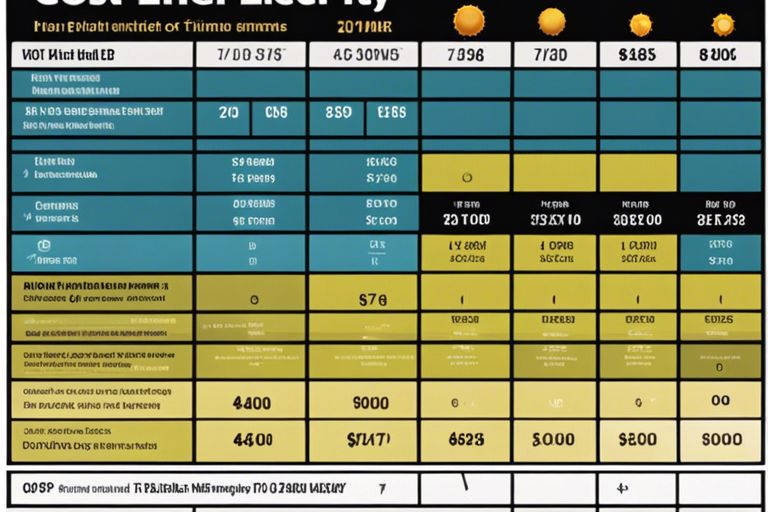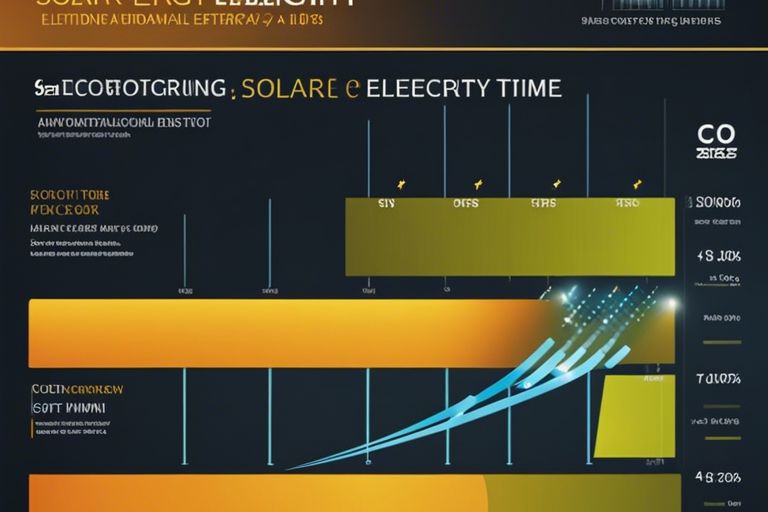There’s a common belief that solar energy is more cost-effective than traditional electricity, but have you ever stopped to really analyze the numbers? In this informative post, we’ll explore into the intricacies of the costs associated with both solar and traditional electricity, challenging your assumptions and providing you with a deeper understanding of this complex issue. By the end, you’ll be equipped to make an informed decision on whether solar is truly cheaper for you.
Key Takeaways:
- Solar power costs: In many regions, the cost of solar power has become cheaper than electricity generated from traditional sources like coal or gas.
- Government incentives: Government incentives and tax breaks can significantly reduce the cost of installing solar panels, making solar energy even more cost-effective.
- Long-term savings: While there is an upfront cost to installing solar panels, the long-term savings on electricity bills can make solar power a more economical choice over time.

The Cost of Electricity
Traditional Sources: Fossil Fuels and Nuclear Power
Costs associated with traditional sources of electricity, such as fossil fuels and nuclear power, can be significant. The extraction, processing, and transportation of fossil fuels, like coal and natural gas, incur expenses that are passed on to consumers. Additionally, the need for continuous monitoring, maintenance, and upgrades of fossil fuel power plants adds to the overall cost of electricity generation.
Transmission and Distribution Costs
Transmission and distribution costs refer to the expenses incurred in transporting electricity from power plants to homes and businesses through a network of power lines and substations. These costs include the maintenance of infrastructure, such as power lines and transformers, as well as operational expenses to ensure a reliable supply of electricity to end-users. While these costs are necessary for delivering electricity efficiently, they can contribute significantly to the total electricity bill.
Understanding the breakdown of transmission and distribution costs can help you assess the true value of electricity consumption. By being aware of the investments required to maintain the electricity grid, you can better understand how these costs factor into the price you pay for electricity.
The Cost of Solar Energy
Initial Investment: Panel Installation and Maintenance
Little did you know that the initial investment in solar energy, including panel installation and maintenance, can be a significant factor in determining the overall cost-effectiveness of solar power for your home. While installing solar panels can be a sizable investment upfront, it is crucial to consider the long-term savings and benefits that come with harnessing the power of the sun.
Decreasing Costs: Advancements in Technology
Costs associated with solar energy have been decreasing over the years due to advancements in technology. Innovations in solar panel manufacturing processes and increased competition in the market have driven down the overall costs of solar energy systems. This means that now more than ever, solar energy is becoming a more affordable and accessible option for homeowners looking to switch to renewable energy sources.
Furthermore, as technology continues to improve, solar panels are becoming more efficient at capturing and converting sunlight into usable energy. This increased efficiency not only translates into more savings on your electricity bills but also reduces the overall payback period for your initial investment in solar panels.
Maintenance
Maintenance costs associated with solar panels are relatively low, as solar panels require minimal upkeep to continue functioning optimally. With proper installation and occasional cleaning, your solar panels can last for decades, providing you with clean and sustainable energy for years to come.

Levelized Cost of Energy (LCOE)
What is LCOE?
The Levelized Cost of Energy (LCOE) is a metric used to compare the lifetime cost of different energy sources. It takes into account the total costs of building, operating, and maintaining a power plant, as well as the amount of electricity it can generate over its lifetime. By calculating the LCOE, you can determine the average price at which electricity must be sold for the power plant to break even over its operational life.
LCOE Comparison: Solar vs. Electricity
| Cost Component | Solar |
| Initial Investment | Higher upfront costs for solar panels and installation |
| Operating and Maintenance Costs | Lower for solar due to minimal moving parts and maintenance requirements |
| Lifetime Output | Varies based on location and efficiency, but generally lower than traditional sources |
When comparing the LCOE of solar energy to traditional electricity sources, it’s crucial to consider various cost components. While solar may have higher initial investment costs, its lower operating and maintenance expenses can offset this over time. However, the lifetime output of solar panels can be lower than traditional sources, impacting the overall cost-effectiveness of solar energy.
LCOE Comparison: Solar vs. Electricity
| Cost Factor | Solar |
| Environmental Impact | Lower carbon footprint and reduced reliance on fossil fuels |
| Price Stability | Less susceptible to fuel price fluctuations |
| Government Incentives | Potential for tax credits and rebates to reduce initial costs |
Plus, solar energy offers additional benefits beyond cost considerations. It has a lower environmental impact, helping reduce carbon emissions and dependence on fossil fuels. Solar energy also provides price stability as it is less susceptible to fluctuations in fuel prices. Additionally, there are various government incentives available, such as tax credits and rebates, that can further reduce the initial costs of installing solar panels, making it a more attractive long-term investment.

Environmental Factors
Despite the initial cost comparison between solar energy and traditional electricity, there are several environmental factors to consider when evaluating the true cost. Here are some key points to keep in mind:
- With solar energy, you significantly reduce your carbon footprint compared to using electricity generated from fossil fuels. Solar power produces clean, renewable energy that helps combat climate change by minimizing harmful greenhouse gas emissions.
- The long-term environmental benefits of solar energy, such as reduced air and water pollution, outweigh the potential savings from traditional electricity sources.
Carbon Emissions: A Hidden Cost of Electricity
With traditional electricity production, the burning of fossil fuels releases large amounts of carbon dioxide and other pollutants into the atmosphere. This contributes to global warming and various environmental issues. In contrast, solar energy systems harness the power of sunlight without emitting harmful greenhouse gases. To learn more about the environmental impact of solar energy compared to fossil fuels, check out Solar Energy vs Fossil Fuels: How Do They Compare?.
Government Incentives: Encouraging Renewable Energy
The government offers various incentives and rebates to encourage the adoption of renewable energy sources like solar power. These incentives can significantly reduce the upfront costs of installing a solar energy system, making it a more attractive and affordable option for homeowners. For instance, you may be eligible for a federal investment tax credit (ITC) that can save you thousands of dollars on your solar installation.
Energy Storage and Grid Parity
The Role of Batteries in Solar Energy
To understand the concept of grid parity, you must first grasp the role of batteries in solar energy. Batteries play a crucial part in solar energy systems by storing excess energy generated during sunny hours for later use when the sun is not shining. This means that with the help of batteries, you can have a reliable supply of electricity even when the sun goes down or on cloudy days. The advancements in battery technology have made solar energy more efficient and dependable, bringing us closer to achieving grid parity.
When Will Solar Reach Grid Parity?
Role of Batteries in Solar Energy play a key role in determining when solar energy will reach grid parity – the point at which the cost of generating solar power is equal to or cheaper than electricity from the grid. Various factors such as the cost of solar panels, battery storage, and government incentives influence the timeline for achieving grid parity. Understanding these components can help you navigate the transition to solar energy and determine when it will become a cost-effective alternative to traditional electricity sources.
Solar energy is steadily moving towards grid parity as technological advancements drive down costs and increase efficiency. With the declining prices of solar panels and batteries, coupled with supportive policies and incentives, the day when solar energy will be cheaper than grid electricity is not far off. Embracing solar power not only benefits you economically but also contributes to a more sustainable energy future for all.
Real-World Examples
Residential Solar: Cost Savings for Homeowners
All around the country, homeowners are making the switch to solar energy and reaping the benefits of cost savings. An increasing number of households are opting for solar panels on their roofs, which not only help the environment but also reduce electricity bills significantly. When you invest in residential solar panels, you can see a noticeable decrease in your monthly electricity expenses, making it a financially wise decision in the long run.
Commercial Solar: Large-Scale Energy Savings
Cost-effective solutions are not limited to residential setups. Commercial enterprises are also finding that solar power can lead to substantial savings on their energy bills. Implementing solar panels on a larger scale can result in significant cost reductions for businesses. By generating your own electricity through solar power, you can decrease your reliance on traditional energy sources and stabilize your long-term energy costs.
For instance, businesses that switch to solar energy often benefit from government incentives and rebates, making the initial investment even more attractive. Additionally, as technologies improve and the cost of solar panels continues to decrease, the return on investment for commercial solar projects becomes even more appealing.
To wrap up
Following this informative exploration, you may now have a clearer understanding of the cost dynamics between solar energy and traditional electricity. By considering factors such as upfront expenses, long-term savings, and environmental impact, you can make a more informed decision on whether solar is truly cheaper than electricity in the long run. Keep in mind, the choice you make not only impacts your wallet but also the planet we all share.
FAQ
Q: Is solar energy really cheaper than traditional electricity?
A: In many cases, yes. The initial cost of installing solar panels can be significant, but the long-term savings on electricity bills can make it a cost-effective option. Additionally, with various incentives, tax credits, and rebates available for solar installations, the overall cost can be further reduced.
Q: How does the cost of solar energy compare to conventional electricity sources?
A: The cost of solar energy has been decreasing steadily in recent years, making it increasingly competitive with traditional electricity sources. In many regions, especially where sunlight is abundant, solar power can be cheaper than electricity from the grid. The key is to calculate the payback period for a solar installation based on factors like local sunlight exposure, energy consumption, and available incentives.
Q: Are there any hidden costs associated with choosing solar energy over traditional electricity?
A: While solar energy can be a cost-effective option, there are some potential hidden costs to consider. These may include maintenance expenses for the solar panels, replacement costs for components over time, and costs related to connecting your system to the grid. It’s important to factor in these potential costs when evaluating the overall financial benefits of choosing solar energy.
